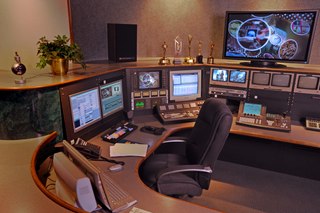Related Research Articles

Video is an electronic medium for the recording, copying, playback, broadcasting, and display of moving visual media. Video was first developed for mechanical television systems, which were quickly replaced by cathode-ray tube (CRT) systems which, in turn, were replaced by flat panel displays of several types.

VHS is a standard for consumer-level analog video recording on tape cassettes.

Non-linear editing is a form of offline editing for audio, video, and image editing. In offline editing, the original content is not modified in the course of editing. In non-linear editing, edits are specified and modified by specialized software. A pointer-based playlist, effectively an edit decision list (EDL), for video and audio, or a directed acyclic graph for still images, is used to keep track of edits. Each time the edited audio, video, or image is rendered, played back, or accessed, it is reconstructed from the original source and the specified editing steps. Although this process is more computationally intensive than directly modifying the original content, changing the edits themselves can be almost instantaneous, and it prevents further generation loss as the audio, video, or image is edited.

S-VHS (スーパー・ヴィエイチエス), the common initialism for Super VHS, is an improved version of the VHS standard for consumer-level video recording. Victor Company of Japan introduced S-VHS in Japan in April 1987, with their JVC-branded HR-S7000 VCR, and in certain overseas markets soon afterward. By the end of 1987, the first S-VHS VCR models from other competitors included Hitachi VT-2700A, Mitsubishi HS-423UR, Panasonic PV-S4764, RCA VPT-695HF, and Toshiba SV-950.
Linear video editing is a video editing post-production process of selecting, arranging and modifying images and sound in a predetermined, ordered sequence. Regardless of whether it was captured by a video camera, tapeless camcorder, or recorded in a television studio on a video tape recorder (VTR) the content must be accessed sequentially.
A hard disk recorder (HDR) is a system that uses a high-capacity hard disk to record digital audio or digital video. Hard disk recording systems represent an alternative to reel-to-reel audio tape recording and video tape recorders, and provide non-linear editing capabilities unavailable using tape recorders. Audio HDR systems, which can be standalone or computer-based, are typically combined with provisions for digital mixing and processing of the audio signal to produce a digital audio workstation (DAW).

A camcorder is a self-contained portable electronic device with video and recording as its primary function. It is typically equipped with an articulating screen mounted on the left side, a belt to facilitate holding on the right side, hot-swappable battery facing towards the user, hot-swappable recording media, and an internally contained quiet optical zoom lens.
Betacam is a family of half-inch professional videocassette products developed by Sony in 1982. In colloquial use, "Betacam" singly is often used to refer to a Betacam camcorder, a Betacam tape, a Betacam video recorder or the format itself.
An edit decision list or EDL is used in the post-production process of film editing and video editing. The list contains an ordered list of reel and timecode data representing where each video clip can be obtained in order to conform the final cut.

HDV is a format for recording of high-definition video on DV cassette tape. The format was originally developed by JVC and supported by Sony, Canon, and Sharp. The four companies formed the HDV Consortium in September 2003.

U-matic is an analogue recording videocassette format first shown by Sony in prototype in October 1969, and introduced to the market in September 1971. It was among the first video formats to contain the videotape inside a cassette, as opposed to the various reel-to-reel or open-reel formats of the time. The videotape is 3⁄4 in (19 mm) wide, so the format is often known as "three-quarter-inch" or simply "three-quarter", compared to open reel videotape formats in use, such as 1 in (25 mm) type C videotape and 2 in (51 mm) quadruplex videotape.
Memorex Corp. began as a computer tape producer and expanded to become both a consumer media supplier and a major IBM plug compatible peripheral supplier. It was broken up and ceased to exist after 1996 other than as a consumer electronics brand specializing in disk recordable media for CD and DVD drives, flash memory, computer accessories and other electronics.
Offline editing is part of the post-production process of film making and television production in which raw footage is copied and the copy only is then edited, thereby not affecting the camera original film stock or video tape. Once the project has been completely offline edited, the original media will be assembled in the online editing stage.

2-inch quadruplex videotape was the first practical and commercially successful analog recording video tape format. It was developed and released for the broadcast television industry in 1956 by Ampex, an American company based in Redwood City, California. The first videotape recorder using this format was built in the same year. This format revolutionized broadcast television operations and television production, since the only recording medium available to the TV industry until then was film used for kinescopes.
Digital audio cassette formats introduced to the professional audio and consumer markets:

Sony HDVS is a range of high-definition video equipment developed in the 1980s to support an early analog high-definition television system thought to be the broadcast television systems that would be in use today. The line included professional video cameras, video monitors and linear video editing systems.
The Massbus is a high-performance computer input/output bus designed in the 1970s by Digital Equipment Corporation (DEC). The architecture development was sponsored by Gordon Bell and John Levy was the principal architect.
Strassner Editing Systems (SES) was a line of PC-based linear "CMX style" keyboard video editing controllers invented in 1988 by Norman H. Strassner in Los Angeles, California.
CMX Editing Systems was a company founded jointly by CBS and Memorex; with help from many individuals such as Ronald Lee Martin, who later became a head of Universal Studios; that developed some of the very first computerized systems for linear and non-linear editing of videotape for post production. The company's name, CMX, stood for CBS, Memorex, and eXperimental.
Adrian Ettlinger was an American electrical engineer and software developer and a pioneer in television and video technology. He has been described as a "visionary" and the "legendary" "engineering father" of non-linear video editing, and has been recognized for his contributions to a range of technologies important to the advancement of television and video as well as several other accomplishments.
References
- ↑ - Rubin, Michael; Diamond, Ron (August 2000) [1991]. Nonlinear: a field guide to digital video and film editing (4th ed.). Gainesville: Triad Publishing Company. p. 46. ISBN 978-0-937404-85-0.
- "CMX Model 600". Museum of Early Video Editing Equipment and Techniques. Archived from the original on July 29, 2013. Retrieved July 29, 2013.
- "ADVANCED ELECTRONIC POST-PRODUCTION TECHNOLOGY TAKES ITS CUE FROM JVC" (Press release). Wayne, NJ: JVC. Archived from the original on July 29, 2012. Retrieved 2013-07-29.Ettlinger has won three Emmy's for his contributions to CMX 600 (the first real time preview system) and other systems
- Turner, Bob (1997). "CMX RIP". Videography. Miller Freeman PSN. Archived from the original on July 29, 2013. Retrieved July 29, 2013. - ↑ - USpatent 3721757,Ettlinger, Adrian B.,"METHOD AND APPARATUS FOR AUTOMATICALLY EDITING. TELEVISION INFORMATION",issued Mar 20, 1973, assigned to Columbia Broadcasting System, Inc.
- Rubin, Michael; Diamond, Ron (August 2000) [1991]. Nonlinear: a field guide to digital video and film editing (4th ed.). Gainesville: Triad Publishing Company. p. 46. ISBN 978-0-937404-85-0.1971: The CMX 600/200 combination costs $500,000 and is patented by CBS, its inventor is Adrian Ettlinger.
- "CMX Model 600". Museum of Early Video Editing Equipment and Techniques. Archived from the original on July 29, 2013. Retrieved July 29, 2013.
- "ADVANCED ELECTRONIC POST-PRODUCTION TECHNOLOGY TAKES ITS CUE FROM JVC" (Press release). Wayne, NJ: JVC. Archived from the original on July 29, 2012. Retrieved 2013-07-29.Ettlinger has won three Emmy's for his contributions to CMX 600 (the first real time preview system) and other systems, as well as the David Sarnoff Gold Medal of SMPTE in 1976 for life achievements.
- Turner, Bob (1997). "CMX RIP". Videography. Miller Freeman PSN. Archived from the original on July 29, 2013. Retrieved July 29, 2013.
- McKernan, Brian, ed. (1996). The Age of Videography. New York: Miller-Freeman PSN. p. 73. ISBN 0-87930-477-4.
- Eller, Claudia (1986). "The Father of Electronic Editing: Adrian Ettlinger". Post: The Magazine for Post Production Professionals: 34–47.